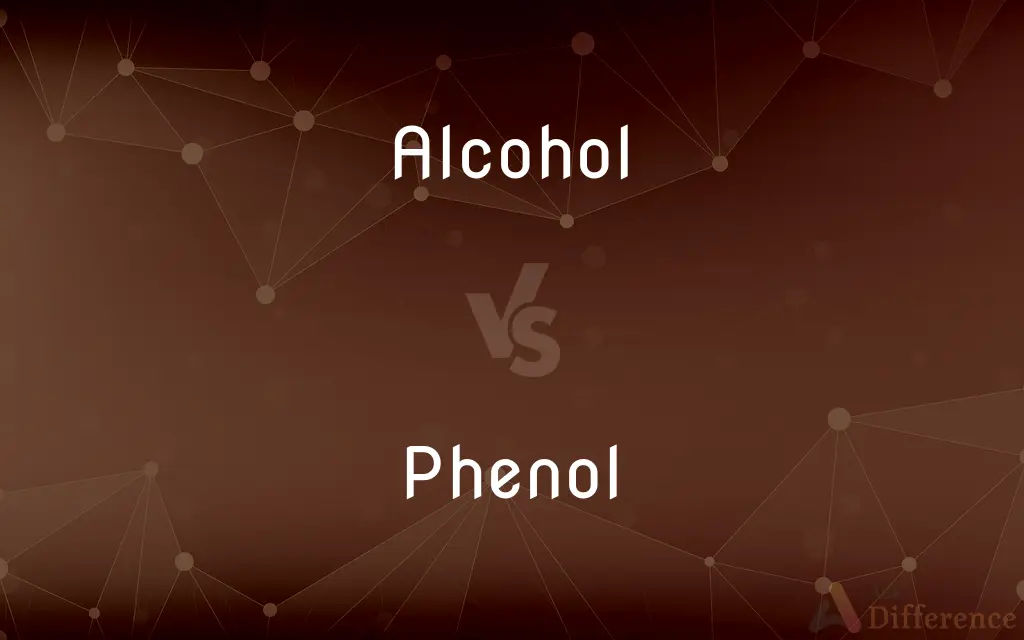Alcohol vs. Phenol — What's the Difference?
By Tayyaba Rehman — Updated on September 22, 2023
Alcohol is an organic compound with a hydroxyl (OH) bonded to a saturated carbon atom. Phenol is a compound where the hydroxyl group is directly bonded to a benzene ring.

Difference Between Alcohol and Phenol
Table of Contents
ADVERTISEMENT
Key Differences
Alcohol and phenol are both organic compounds that contain hydroxyl groups, but their structural contexts and properties vary. Alcohols have a hydroxyl (OH) group attached to a saturated carbon atom. This means the carbon bonded to the hydroxyl group isn't part of a double bond or aromatic ring. Alcohols can be primary, secondary, or tertiary based on the carbon's attachment points to other carbons.
Phenol, on the other hand, specifically denotes a compound where the hydroxyl group is directly attached to a benzene ring, which is an aromatic compound. Because of this direct attachment, phenols exhibit unique properties that differentiate them from alcohols, such as their acidity. Phenols are more acidic than alcohols due to the stabilization of the negative charge on the oxygen after deprotonation by the benzene ring.
While both alcohols and phenols can engage in hydrogen bonding because of their hydroxyl groups, phenols typically have higher boiling points than alcohols of similar molecular weight. This is because of the additional pi-pi stacking interactions possible with the aromatic ring in phenols.
In terms of reactivity, both alcohols and phenols can undergo reactions with their hydroxyl groups. However, the aromatic ring in phenol makes it susceptible to electrophilic aromatic substitution, which isn't a reaction pathway for typical alcohols.
Comparison Chart
Basic Structure
Hydroxyl group bonded to a saturated carbon atom
Hydroxyl group bonded to a benzene ring
ADVERTISEMENT
Acidity
Generally less acidic
More acidic
Boiling Point
Typically lower for similar molecular weights
Higher due to pi-pi stacking
Common Reactions
Esterification, oxidation
Electrophilic aromatic substitution
Example
Ethanol, methanol
Carbolic acid
Compare with Definitions
Alcohol
A substance used in beverages and as a solvent.
Alcohol is a key ingredient in hand sanitizers.
Phenol
The simplest member of the class of phenolic compounds.
Many compounds can be synthesized using phenol as a starting material.
Alcohol
A class of compounds with varied chain lengths and structures.
Methanol and ethanol are both types of alcohol.
Phenol
A substance with a distinct and often sharp smell.
Phenol's aroma can be quite pungent.
Alcohol
A compound known for its intoxicating effects in beverages.
Many cultures have traditions centered around consuming alcohol.
Phenol
An aromatic compound with a hydroxyl group attached to a benzene ring.
Phenol is used in the production of resins.
Alcohol
An organic compound containing a hydroxyl group.
Wine contains alcohol derived from the fermentation of grapes.
Phenol
A compound known for its antiseptic properties.
In the past, phenol was used as a disinfectant.
Alcohol
A hydrocarbon derivative where hydrogen is replaced by a hydroxyl group.
When yeast ferments sugars, it produces alcohol.
Phenol
A white crystalline substance soluble in organic solvents.
When handling phenol, it's essential to use gloves.
Alcohol
In chemistry, alcohol is an organic compound that carries at least one hydroxyl functional group (−OH) bound to a saturated carbon atom. The term alcohol originally referred to the primary alcohol ethanol (ethyl alcohol), which is used as a drug and is the main alcohol present in alcoholic drinks.
Phenol
Phenol (also called carbolic acid) is an aromatic organic compound with the molecular formula C6H5OH. It is a white crystalline solid that is volatile. The molecule consists of a phenyl group (−C6H5) bonded to a hydroxy group (−OH).
Alcohol
A colourless volatile flammable liquid which is produced by the natural fermentation of sugars and is the intoxicating constituent of wine, beer, spirits, and other drinks, and is also used as an industrial solvent and as fuel
The use of petrol containing alcohol
It is an offence to drive if you have more than 80 mg of alcohol per 100 ml of blood
Phenol
A mildly acidic toxic white crystalline solid obtained from coal tar and used in chemical manufacture, and in dilute form (under the name carbolic) as a disinfectant.
Alcohol
Any of a series of hydroxyl compounds, the simplest of which are derived from saturated hydrocarbons, have the general formula CnH2n+1OH, and include ethanol and methanol.
Phenol
A caustic, poisonous, white crystalline compound, C6H6O, derived from benzene and used in resins, plastics, and pharmaceuticals and in dilute form as a disinfectant. Also called carbolic acid.
Alcohol
A colorless volatile flammable liquid, C2H5OH, synthesized or obtained by fermentation of sugars and starches and widely used, either pure or denatured, as a solvent and in drugs, cleaning solutions, explosives, and intoxicating beverages. Also called ethanol, ethyl alcohol, grain alcohol.
Phenol
Any of a class of aromatic organic compounds having at least one hydroxyl group attached directly to the benzene ring.
Alcohol
Intoxicating beverages containing ethanol considered as a group
The national consumption of alcohol.
Phenol
A caustic, poisonous, white crystalline compound, C6H5OH, derived from benzene and used in resins, plastics, and pharmaceuticals and in dilute form as a disinfectant and antiseptic; once called carbolic acid
Alcohol
Any of a class of organic compounds (such as ethanol) containing a hydroxyl functional group (-OH).
Phenol
Any of a class of aromatic organic compounds having at least one hydroxyl group attached directly to the benzene ring (or other aromatic ring)
Alcohol
(colloquial) Ethanol.
Phenol
A white or pinkish crystalline substance, C6H5OH, produced by the destructive distillation of many organic bodies, as wood, coal, etc., and obtained from the heavy oil from coal tar.
Alcohol
(uncountable) Beverages containing ethanol, collectively.
Phenol
Any one of the series of hydroxyl derivatives of which phenol proper is the type.
Alcohol
(obsolete) Any very fine powder.
Phenol
Any of a class of weakly acidic organic compounds; molecule contains one or more hydroxyl groups
Alcohol
An impalpable powder.
Phenol
A toxic white soluble crystalline acidic derivative of benzene; used in manufacturing and as a disinfectant and antiseptic; poisonous if taken internally
Alcohol
The fluid essence or pure spirit obtained by distillation.
Alcohol
Pure spirit of wine; pure or highly rectified spirit (called also ethyl alcohol or ethanol, CH3.CH2.OH); the spirituous or intoxicating element of fermented or distilled liquors, or more loosely a liquid containing it in considerable quantity. It is extracted by simple distillation from various vegetable juices and infusions of a saccharine nature, which have undergone vinous fermentation.
Alcohol
A class of compounds analogous to vinic alcohol in constitution. Chemically speaking, they are hydroxides of certain organic radicals; as, the radical ethyl forms common or ethyl alcohol (C2H5.OH); methyl forms methyl alcohol (CH3.OH) or wood spirit; amyl forms amyl alcohol (C5H11.OH) or fusel oil, etc.
Alcohol
A liquor or brew containing alcohol as the active agent;
Alcohol (or drink) ruined him
Alcohol
Any of a series of volatile hydroxyl compounds that are made from hydrocarbons by distillation
Common Curiosities
Why is alcohol used in hand sanitizers?
Alcohol can kill bacteria and viruses, making it effective for sanitization.
Why is phenol historically significant in surgery?
Phenol was used as an antiseptic to sterilize surgical instruments.
Is alcohol always intoxicating?
No, only specific alcohols, like ethanol, are intoxicating. Others, like methanol, are toxic.
What makes phenol more acidic than alcohol?
Phenol's acidity is due to the stabilization by the benzene ring after deprotonation.
What reactions are typical for phenol?
Phenol undergoes electrophilic aromatic substitution, among others.
Are all alcohols safe to drink?
No, only specific alcohols, such as ethanol, are safe in moderation. Others can be poisonous.
Can phenol be found in household products?
Yes, phenol is found in some disinfectants and throat sprays.
How are alcohols classified?
Alcohols are classified as primary, secondary, or tertiary based on the hydroxyl group's attachment.
Can alcohols form hydrogen bonds?
Yes, the hydroxyl group in alcohols can form hydrogen bonds.
Are there derivatives of phenol?
Yes, many compounds, like salicylic acid, are derived from phenol.
Can alcohol be used as a fuel?
Yes, ethanol, a type of alcohol, is used as a biofuel.
Are there health risks with excessive alcohol consumption?
Yes, excessive consumption can lead to liver disease, addiction, and other health issues.
Is phenol present in cosmetics?
Phenol or its derivatives can be found in some cosmetic products.
Share Your Discovery

Previous Comparison
Conservation vs. Preservation
Next Comparison
Apartment vs. HouseAuthor Spotlight
Written by
Tayyaba RehmanTayyaba Rehman is a distinguished writer, currently serving as a primary contributor to askdifference.com. As a researcher in semantics and etymology, Tayyaba's passion for the complexity of languages and their distinctions has found a perfect home on the platform. Tayyaba delves into the intricacies of language, distinguishing between commonly confused words and phrases, thereby providing clarity for readers worldwide.
















































